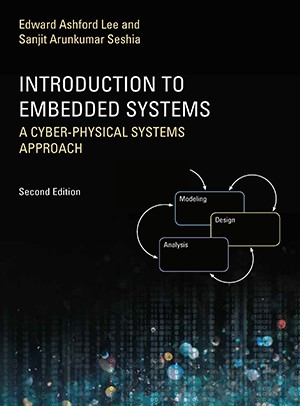
Introduction to Embedded Systems: A Cyber-Physical Systems Approach, Second Edition
This book takes a cyber-physical approach to introduce the engineering concepts underlying embedded systems. The focus is on modeling, design, and analysis of cyber-physical systems, which integrate computation, networking, and physical processes.
Tag(s): Embedded System
Publication date: 30 Dec 2016
ISBN-10: 0262533812
ISBN-13: 9780262533812
Paperback: 568 pages
Views: 11,090
Introduction to Embedded Systems: A Cyber-Physical Systems Approach, Second Edition
 This book takes a cyber-physical approach to introduce the engineering concepts underlying embedded systems. The focus is on modeling, design, and analysis of cyber-physical systems, which integrate computation, networking, and physical processes.
This book takes a cyber-physical approach to introduce the engineering concepts underlying embedded systems. The focus is on modeling, design, and analysis of cyber-physical systems, which integrate computation, networking, and physical processes.
Publication date: 30 Dec 2016
ISBN-10: 0262533812
ISBN-13: 9780262533812
Paperback: 568 pages
Views: 11,090
Document Type: Textbook
Publisher: The MIT Press
License: n/a
Post time: 22 Dec 2016 05:00:00
Lee and Seshia wrote:The most visible use of computers and software is processing information for human consumption. The vast majority of computers in use, however, are much less visible. They run the engine, brakes, seatbelts, airbag, and audio system in your car. They digitally encode your voice and construct a radio signal to send it from your cell phone to a base station. They command robots on a factory floor, power generation in a power plant, processes in a chemical plant, and traffic lights in a city. These less visible computers are called embedded systems, and the software they run is called embedded software. The principal challenges in designing and analyzing embedded systems stem from their interaction with physical processes. This book takes a cyber-physical approach to embedded systems, introducing the engineering concepts underlying embedded systems as a technology and as a subject of study. The focus is on modeling, design, and analysis of cyber-physical systems, which integrate computation, networking, and physical processes.
The second edition offers two new chapters, several new exercises, and other improvements. The book can be used as a textbook at the advanced undergraduate or introductory graduate level and as a professional reference for practicing engineers and computer scientists. Readers should have some familiarity with machine structures, computer programming, basic discrete mathematics and algorithms, and signals and systems.
More Resources:
Tweet
About The Author(s)
Edward Ashford Lee is Robert S. Pepper Distinguished Professor in the EECS Department at the University of California at Berkeley.

Edward Ashford Lee is Robert S. Pepper Distinguished Professor in the EECS Department at the University of California at Berkeley.
Sanjit A. Seshia is Professor in the Department of Electrical Engineering and Computer Sciences at the University of California, Berkeley. He is part of Group in Logic and the Methodology of Science which develops theory and tools to aid the construction of provably dependable and secure systems. Their work spans several abstraction layers, from mathematical models, through software, to electronic and biological substrates.

Sanjit A. Seshia is Professor in the Department of Electrical Engineering and Computer Sciences at the University of California, Berkeley. He is part of Group in Logic and the Methodology of Science which develops theory and tools to aid the construction of provably dependable and secure systems. Their work spans several abstraction layers, from mathematical models, through software, to electronic and biological substrates.